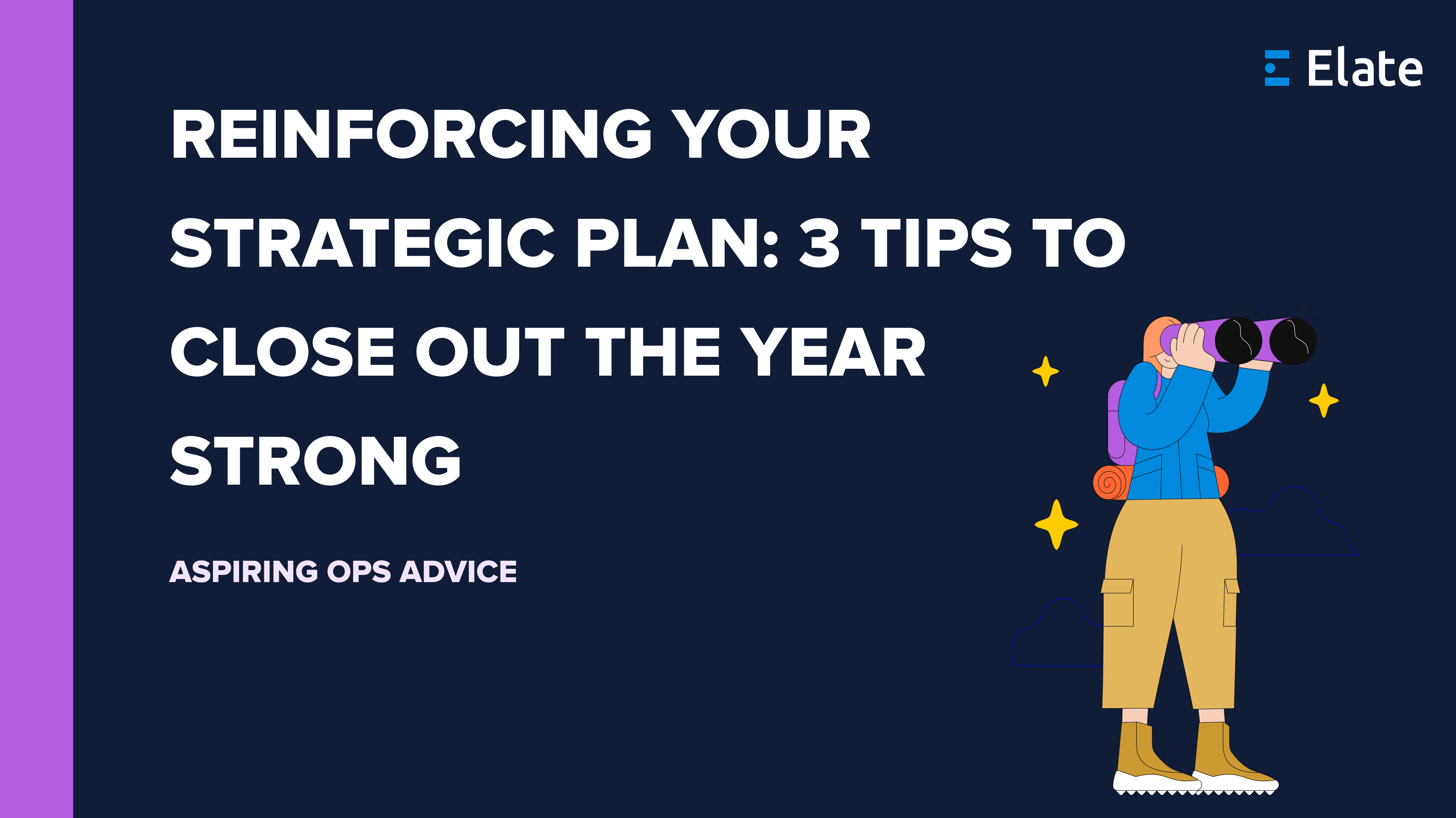
As we quickly approach the second half of the year, it’s very likely that the original strategic plan you had in place to start 2022 has been adjusted, modified, or blown up entirely. And that’s okay. While high-level company objectives and major milestones may remain unchanged, the tactics to get you there have likely shifted to match the changes with overall market conditions.
At Elate, we believe in an approach called Dynamic Planning, which simply refers to the process of proactively evolving your plan to meet the current needs of your business. With traditional strategic planning, it can be more of a ‘check the box’ exercise for leadership and built around capturing static goals with out-of-date data. Dynamic Planning, on the other hand, shifts the mindset of a company to be more proactive and nimble in making decisions that keep you on pace towards reaching your goals.
Oftentimes, companies fall victim to setting a list of goals or OKRs at the beginning of the year, and march towards those objectives, regardless of the actual state of the business or market. So as we approach Q3 and Q4, now is an opportune time to revisit your strategic plan and ensure your team is aligned towards mission critical objectives for the company.
For many, this starts by creating a unified view of your plan that can drive accountability and a cadence for regular review. For others, this might mean finally making the transition from planning to executing, and not allowing perfection to be the enemy of good when it comes to communicating your objectives to employees and team members.
Regardless of where you’re at in the process, here are three recommendations to ensure your company closes out the year on a high note.
Recommendation 1: Set a Direction and Be Okay Writing it in Pencil
If you have never truly rolled out your strategic plan and company objectives to employees, you’re not alone. Many companies struggle to make the transition from planning to execution, and struggle to roll out a plan that can be communicated with employees. There is often a hesitation around sharing the plan to everyone until it is perfect. The truth is, there really isn’t a perfect plan.
One of the benefits to Dynamic Planning is that it allows for flexibility. Whether it’s the chance to pursue new opportunities as they present themselves to your business, or shifting away from initiatives that are no longer relevant, Dynamic Planning establishes a cadence for proactively reviewing the direction of the company and the tactics for how you get there.
As Abby Parker, COO at Elate, shared on her episode of Aspiring Ops, often the hesitation to finalize your plan starts at the leadership level, and this hesitation can reverberate across the company.
Commit to your direction, but be willing to adjust how you get there. While it might seem ambiguous, this is often where great strategy and operations leaders can thrive within a business. By understanding that plans will change and new opportunities will present themselves, companies can ensure there is alignment on overall direction, and adjust the tactics as needed to get there. This is much easier when you’ve clearly communicated a direction, rather than assumed team members know what they should be focusing on in their roles.
Recommendation 2: Allow Healthy Conversation on Where You’ve Been to Set the Stage for Where You Go
The first half of the year might not have gone as expected. But rather than just settling for H2 being more of the same, be willing to stop and ask ‘why?’. Whether you struggled to roll out OKRs or your 2022 strategic plan was never finalized, there are countless reasons why a company might struggle to have alignment on key initiatives through the first half of the year.
However, this isn’t an invitation to simply stick your head in the sand and hope for the best. Rather, this is a perfect opportunity to create an open forum with other leadership team members to reflect on where you’ve been, good or bad, and set the stage for closing out the year strong.
To do this, we recommend a retrospective of the first two quarters of the year.
For some companies, this might look like a true retro of your existing strategic plan that was agreed upon by leadership. Some common questions may include:
- How are we doing as a team staying focused on priorities?
- Are we hitting the goals we originally set?
- Is there a clear cadence for how we’ve been reviewing leadership OKRs on a regular basis?
For some of these, you might be knocking your goals out of the park. For others, there might be room for work. Regardless of where you’re at, this forum is a great place to start realigning for the final stretch of the year.
Let’s take it a layer deeper…For some companies, you might not know where to start, because you never agreed upon a strategic plan in the first place. You had your leadership offsite back in the fall, but fundraising threw off your timing for getting approval. Now, you find yourself just spinning your wheels trying to hit arbitrary goals or OKRs.
If that’s the case, this is a great opportunity to ask the rest of your leadership team a simple question: What would we be disappointed about if we didn’t achieve it by the end of the year?
There will never be a lack of new ideas to take on or OKRs to set, but rather than overwhelming your team with all the potential opportunities, simplify it into the critical things you’d be disappointed about not achieving as a company in the next six months.
This can help set the stage for closing the year out together, aligned on what matters most.
Recommendation 3: Don’t Let the Struggles of Q1 + Q2 Set the Course for How You End the Year
Oftentimes, the failure to roll out a strategic plan can lead to waving the white flag on OKRs or any semblance of an operating framework. For many employees, OKRs, or any goal-setting framework, often comes with scar tissue from poor attempts at using an OKR framework in the past. This can lead to a willingness to abandon ship at the first signs of trouble, and in turn leave your company in a constant state of rebuilding, never committing to any operating framework because none are perfect. If that’s the case, your team will struggle to ever find the solution to create the alignment and accountability you are so badly seeking.
One of the most common responses we hear from strategy and operations leaders is that the framework just didn’t work this year, so we’re going to wait until next year. As Abby explains, this is a trap that so many companies fall into time and time again.
If you’ve struggled to gain alignment or accountability in the first half of the year, there couldn’t be anything riskier to the chances of hitting your company goals than sunsetting your strategic plan mid-year.
While a company might have the best intentions to pick back up next year and roll out OKRs from the lessons learned, the likelihood is you will experience the same challenges next year. At some point, it takes a firm commitment to go through natural growing pains and evolution that is required to implement the right structure for your team.
Peter Clare is the current President of Jobvite and former SVP of Operations. As he shares on Aspiring Ops, Peter sets himself and his team members up for success by his commitment to establishing an operating framework that creates a regular rhythm and cadence for solving these challenges.

As Peter shares, “Ignoring the operating system isn't an option.”
But as Peter also points out, any operating system only works and thrives if your team is willing to put in the work to constantly evaluate what’s best for your business.
To put this into practice, Jobvite puts a pause on all corporate meetings during the last week of the quarter. By taking all of their corporate meetings off the calendar, it helps the company reset on what meetings and processes are important. What meetings are mission critical? What parts of the process aren’t serving the company? What needs to change to better serve the company as we scale?
So for those hoping to have a perfect initial rollout of OKRs or any strategic framework, rest assured that even for the best strategy and operations leaders, change and growth is inevitable. What’s more important is conveying the ‘why’ to team members and conveying a strong foundation that supports the change to come.
Tackling Strategic Planning and Execution Together
As we head into the second half of the year, don’t let hiccups in rolling out your OKRs or strategic plan in the first half prevent you from optimizing your company for success. The second half of the year is often where companies look to hit their stride, leveraging the learnings from Q1 and Q2 to set the direction for how they execute against goals critical to success.
But you don’t have to do it alone. We’re here to help.
At Elate, we’re a team of former Strategy and Operations Leaders who saw the need to evolve the way companies think about strategic planning and execution. Built by Strategy and Operations Leaders for Strategy and Operations Leaders, Elate helps high-growth companies build, execute, and review their strategic plan to drive alignment and visibility like never before.
If you’re interested in learning more about our team of experts, feel free to reach out to our team today to schedule time to connect.
As we all continue to chase the vision in front of us, we are here to guide, support, and connect you, every step of the way. When you partner with Elate, we tackle strategic planning together with your company’s vision at the center.


